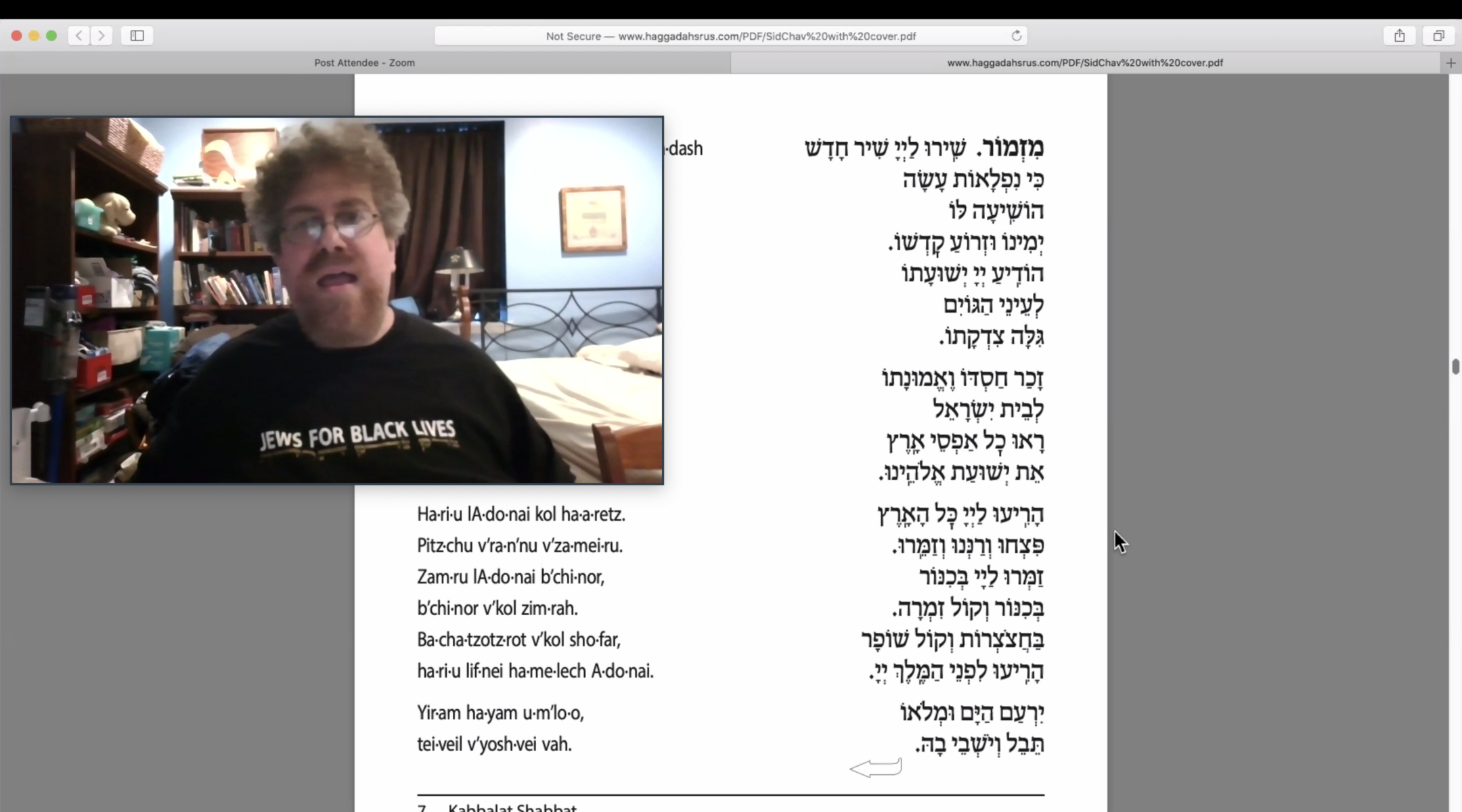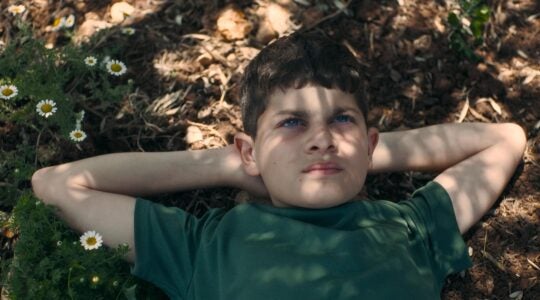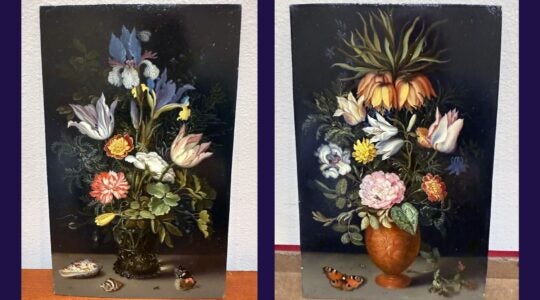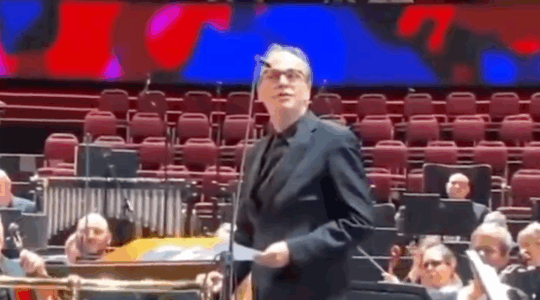(JTA) — February was hours away from ending when Russ Agdern stood at the center of the room at a Jewish retreat center in Maryland, singing with all of the spirit he could muster.
The space was packed, the voices strong and the energy electric as Shabbat came to a close, Agdern recalls about the penultimate afternoon of the spring retreat of the National Havurah Committee, a group that promotes intimate, informal Jewish communal experiences.
Few if any in the room were thinking about the potent new virus that had paralyzed parts of China and begun to kill people in Italy. But COVID-19 was already circulating in New York City, and the Jewish lawyer who would become the East Coast’s “patient zero” was already feeling sick. Choirs in Washington state and the Netherlands were days away from rehearsals and performances that would be attributed to the deaths of multiple singers. Within weeks, all communal activity would cease and singing would be recognized as an especially dangerous activity in the coronavirus era.
“We could have been one of those superspreader events really easily,” Agdern recalls. “We had people jammed into a small room to sing together because close spaces are what you need for good unamplified, thoughtful singing.”
A founder of a Brooklyn minyan, Shir HaMaalot, whose name includes the Hebrew word for song, Agdern has spent the past six months trying to rethink a core activity of American Jewish life, communal singing, for the pandemic era. Over the weekend, he led a Shir HaMaalot service on Friday night; participated in a Brooklyn-wide Selichot service Saturday night; and organized a High Holidays-themed singalong on Sunday afternoon — all virtually.
“If I didn’t have the ability to sing with people for a year, I wouldn’t make it,” Agdern said. “Singing is always how I expressed myself and how I prayed. … The loss is massive.”
That loss is being felt deeply across the Jewish world, where so many others like Agdern are working to fill the gap with virtual singalongs, innovative productions and unlikely collaborations. As with so much since the pandemic began, those efforts are yielding comfort and meaning — but in many ways remain unsatisfying approximations in the strange new world of online prayer, where time lags mean cacophony is avoided only if everyone but the song leader is muted.
“Jewish worship services are the majority sung, and so to take away doing that with people, it shakes everyone up,” said Rachel Brook, a cantor at New York City’s Park Avenue Synagogue. “How do we experience prayer, and how do we experience community, and how do we experience worship if we’re not feeling it in real time?”
As early as the mid-19th century, Jewish congregations began to measure their success by the quality of their choirs, according to Judah Cohen, a professor of Jewish studies and musicology at Indiana University. In the 20th century, the influence of song leaders such as Debbie Friedman and Shlomo Carlebach transformed Jewish singing from the province of professionals to the shared responsibility of the congregation.
“Often people will talk about the health of their community, of one’s identity or of Judaism by how well people sing together,” Cohen said. “Music is so central to what it means to create community in congregations and other kinds of sacred spaces. … Being ripped from the sense of what has been established as satisfying practice can lead to a destabilizing of what it means to be a community more broadly.”
More recently, a cohort of people like Agdern have sought to center communal prayer around the niggun, or wordless melodies that are rooted in the Hasidic tradition. Many have learned from Joey Weisenberg, the founder of Hadar’s Rising Song Institute who has spent the last two decades exhorting Jews to let their emotions drive their voices, and to huddle up and sing together.
“We did a lot of work to get people off the bimah and to feel each other’s song and spirits,” Weisenberg said. “COVID is a major setback for that sense of mission.”
And yet there is no way around it: Singing together in person is dangerous right now. The alarming reports of superspreader choir rehearsals gave rise to an early recommendation from experts convened by five American choral associations in May against any chorus rehearsals or performances until an effective vaccine is available and widely adopted. More recently, researchers in Sweden concluded that singing with a mask is akin to speaking without one, making the activity perhaps less uniquely perilous but no less inadvisable.
“The absolute devastating effect of learning that the thing that you love to do the most is suddenly really dangerous, akin to riding your bike down a hill slicked with oil without a helmet — it’s a real shock,” said Joanna Dulkin, the cantor at Adath Jeshurun Congregation, a Conservative synagogue in Minnetonka, Minnesota. “People are reeling from that.”
Around the world, efforts are underway to find a path back to communal singing. Broadway artists developed a “singer’s mask” that acts as a barrier for aerosol droplets while still letting vocalists breathe deeply and project their voices. Scientists in England are engaged in a rigorous study of when and how singing can safely happen. And some houses of worship, including synagogues, are constructing Plexiglas barriers to allow their leaders to sing without putting their congregants at risk.
But those solutions are designed for situations where one person is performing. There is no safety fix for the kind of communal singing that Agdern cherishes and Weisenberg urges, or for the robust choruses that many synagogues put together for High Holiday services.
Nor can those experiences translate cleanly to Zoom, as anyone who has tried to sing “Happy Birthday” during a pandemic gathering knows. Zoom “is good for delivering a lecture, or singing a song at people, but because of the lag time, it’s not good for real, in-time live communication, which is at the heart of the in-person experience of davening and music making,” Weisenberg said.
Typically, Dulkin would have spent the late summer holding live rehearsals with her synagogue’s volunteer choir preparing for Rosh Hashanah and Yom Kippur, when the voices of its 20 members would unite to project the soaring melodies that evoke the feelings of the holidays.
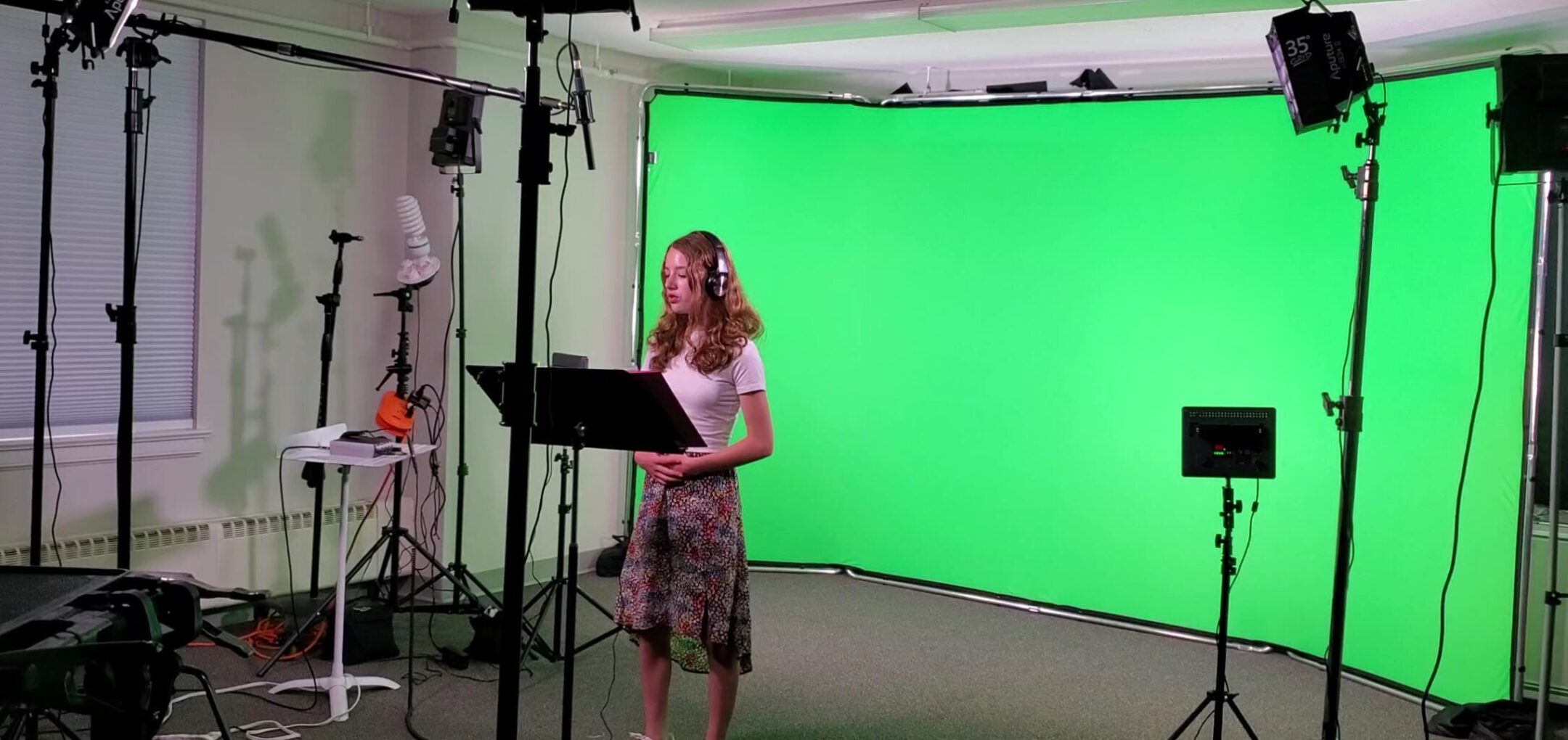
Noa Parker, 14, records as part of a virtual choir effort arranged by her synagogue, Congregation Adath Jeshurun in Minnetonka, Minn. (Courtesy of Joanna Dulkin)
This year, community members recorded their parts individually from their homes or a studio set up in a nearby church, while Dulkin and others applied a crash course in music-mixing apps such as GarageBand to compile them into a single harmonious performance that will play during Adath Jeshurun’s streamed services.
Dulkin, who is also the vice president of the Conservative movement’s Cantors Assembly, said she was heartened by the number of congregants who chose to participate. At the same time, she said recording and mixing virtual choirs, an approach many synagogues have adopted, comes at a cost.
“When we’re together, all of a sudden there’s a harmony, there’s someone adding percussion, maybe the leader decides to go, ‘One more time with the niggun,’” she said. “Now we have to sacrifice spontaneity if we want multiple voices together.”
Still, Dulkin has been encouraging her congregants to sing along at home and said she is confident that singing can generate spiritual experiences even when only one voice can be heard.
“I’ve taken to saying, ‘You’re officially on mute but I want you to sing along loudly. Maybe you’ll be moved to dance. Maybe today’s the day you’ll have an out-loud conversation with God during the Amidah,’” she said. “‘Just because you’re silent to me, that doesn’t mean you have to be passive.’ That’s resonated with people.”
Others are also experiencing success in holding meaningful online song sessions.
The Chicago Niggun Circle, an informal group of area Jews interested in wordless singing, called off its regular meetings once the pandemic hit. But after a while, realizing that in-person services remained a long way off, the group resumed meeting online, playing recordings of communal singing to which members could add their voices and sharing songs in advance to compensate for the loss of fortuity.
“You’re missing the spontaneous harmonization or changing up of the songs,” said Emily Feder, a software developer who helped found the group last year. “But I feel like I adapt pretty well. Part of life now is enjoying the things that are positive.”
Agdern filled his spring and summer with virtual experiences that sated some of his thirst for joyful communal singing. For Passover, inspired in part by the fact that Agdern’s own family Seder is punctuated by unique songs, Shir HaMaalot asked members to share holiday melodies. Untethered by geography, Agdern led and joined services held by other singing-oriented groups, including Tikkun Leil Shabbat in Washington, D.C. He’s experimented with unmuting participants randomly during virtual services, so at least one voice besides the song leader shines through — even if it isn’t perfectly timed or in tune.
“People are trying to find ways to do it because we need to,” he said.
For professional Jewish singers, the pandemic is giving rise to new collaboration and creativity. Camp song leaders have been holding virtual song sessions that have drawn not just the children and teenagers whose summer seasons were canceled by the pandemic but generations of alumni who have come together to belt out familiar tunes.
Several popular song leaders have created a customizable High Holiday service for families that synagogues can purchase, ensuring that their congregants will get a high-quality musical experience online this year.
And the Cantors Assembly’s SongSwap initiative has taken on new energy, with dozens of cantors and others coming together frequently to share new melodies that may make their way into synagogue services well after the pandemic has ended.
Brook, the Park Avenue cantor, had planned this spring to launch a new choral group, the Shul Sisters, with colleagues in Los Angeles and suburban Chicago. Instead of holding a debut concert, they released a video in July that also includes three Black Christian clergy, in a response to the summer’s racial justice protests. That collaboration would never have happened had the pandemic not transformed communal singing into a coordinated individual effort, Brook said.
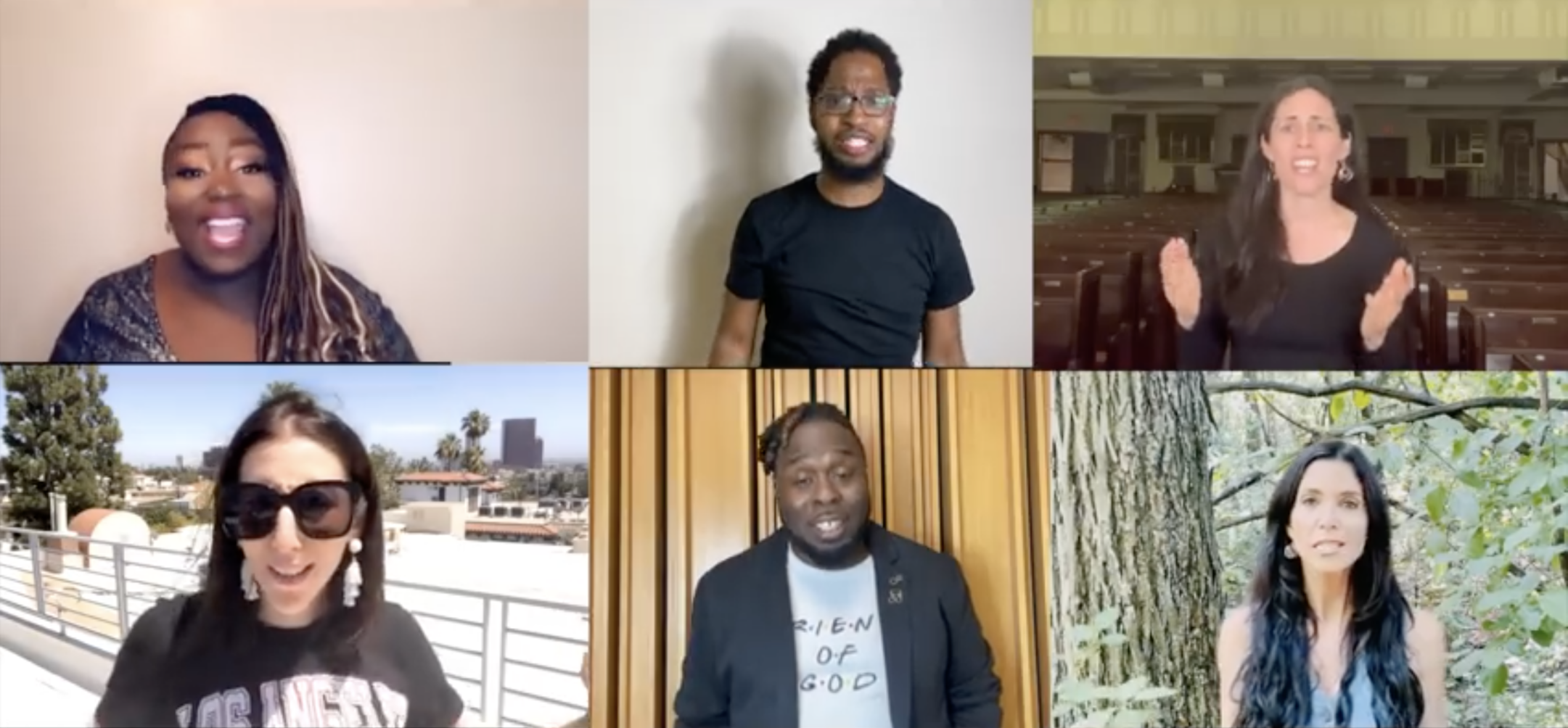
Rachel Brook, upper right, is one of three cantors in the Shul Sisters, a singing group that entered new collaborations because of the pandemic. (Screenshot)
“The democracy of singing is a deep loss — there’s just no way around that. But even though it’s a different thing, the amount of online content that has been produced just opens up a different side of us,” Brook said. “If you’re hungry for Jewish musical and artistic connection, yes, one avenue is now closed, but so many other avenues are opening up.”
Weisenberg, too, is appreciating the benefits of virtual collaboration. Work on a forthcoming album, he said, is “no longer limited to when the whole band can get together for an hourlong rehearsal here or there.” He’s also devoting energy toward developing training materials and online classes aimed at helping people become what he calls “baalei neginah,” or masters of song.
“This unique time of communal isolation is an opportunity for everyone to learn nusach and niggun — to become leaders of Jewish song — so that when we finally do come back together again in person, our voices and our communities will be that much stronger,” Weisenberg said.
Now that some congregations have begun holding small-scale, socially distanced, usually outdoor services, communities must contend with just how much singing to permit. Leaders must weigh the risks they know singing carries against the power they know that song holds in Jewish tradition.
“Certain parts you traditionally sing, and parts that we don’t traditionally sing, we won’t sing,” said Binyamin Blau, rabbi of Cleveland’s Orthodox Green Road Synagogue, which is holding multiple in-person High Holidays services this month. “But if the davening is totally dry, it loses its meaning.”
The balancing act has felt especially precarious in California, where the state briefly barred singing during worship services this summer, then issued vague guidance that required prayer leaders to apply their own judgment about what constituted safe song.
Hillary Chorny, a rabbi and cantor at Temple Beth Am, a Conservative synagogue in Los Angeles, recalls feeling anxious after realizing she would need to tell congregants to sing less spiritedly after years of encouraging them to raise their voices.
Now that Chorny’s synagogue has begun holding some outdoor prayer services, she said congregants have been let down by the approach to singing, for all sorts of reasons.
“We are disappointing the ones who want to sing more, and think it’s preposterous that we’re holding back, perhaps even ridiculous that we’re requiring masks, who think that this is a mere facsimile of what services were and should be,” Chorny said. “And we are disappointing the ones who think we were dangerously loud, who suspect that the original regulation prohibiting all singing should have held, and who think that even the whispers and hums … pushed reasonable limits.”
The majority of congregants, Chorny said, fell somewhere in the middle — as did she.
“Most people were moved to tears just to be back. To hear a few tunes. To hum a few tunes,” she said. “And I remain torn, ambivalent, emotionally exhausted by the game of encouraging only just enough singing. Empathetic to every point on that curve.”
As the pandemic wears into its seventh month, Agdern said he has settled into an uneasy truce with online singing. He’s planning another song session that he’s calling Ochila, Hebrew for “I will hope,” for later this month.
But he said he can imagine the day that Jews can close their computers and again allow their voices to rise in harmony.
“I think it’s going to be lost for a while. But I can imagine a moment when there’s a vaccine, when lots of people have gotten the vaccine, maybe we’re talking Shavuot 2022, or High Holidays 2021 if we’re lucky, when it’s going to be like the floodgates open,” Agdern said. “At least I know it will be for me.”
JTA has documented Jewish history in real-time for over a century. Keep our journalism strong by joining us in supporting independent, award-winning reporting.
